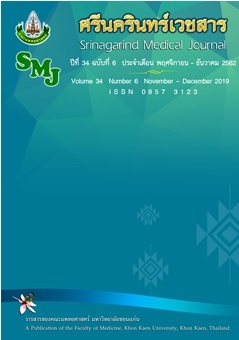Effectiveness of Artificial Cheeks for Bag Mask Ventilation in Elderly Patients Receiving General Anesthesia
Keywords:
effectiveness; artificial cheeks; bag-mask ventilation; general anesthesiaAbstract
Background and Objective: Lack of teeth and sunken cheeks could cause bag-mask ventilation difficulty in anesthetized elderly patients because of inadequate air-tight seal. Those are the reason why we invented artificial cheeks to solve the problems. The purposes of this study were to evaluate the effectiveness of using artificial cheeks during bag-mask ventilation.
Methods: The process of investigation were divided into 3 steps. First step was artificial cheeks invention. Second step was the devices application for with patients, and third step was evaluation by using questionnaire from anesthesia personnels who had used artificial cheeks. The respondents were asked to evaluate all 6 aspects; 1) good sealness 2) easy to ventilate 3) convenience to use 4) easy cleanness 5) easy storage and 6) overall satisfaction. The evaluated scales included the followings; 4 = excellent, 3 = good, 2 = fair, 1 = poor. The sample size calculation was based on the effectiveness of using artificial cheeks of at least 90 %, so the total sample size was 40.
Results: The overall score of effective assessment (80-90%) evaluated by respondents was 3.2-3.25. The average of highest score of all aspects (>90%) was easy cleanness 3.7-3.9 whereas the average of lowest score was good sealness (3.2).
Conclusion: The effectiveness of using artificial cheeks for bag-mask ventilation in elderly patients were moderate to high. The artificial cheeks can be used to assist bag-mask ventilation in anesthetized elderly patient.
References
2. รายงานประจำปีและสถิติภาควิชาวิสัญญี คณะแพทยศาสตร์ มหาวิทยาลัยสงขลานครินทร์; 2559.
3. พัชรียา นิวัฒน์ภูมินทร์. การให้ยาระงับความรู้สึกในผู้ป่วยสูงอายุ. ใน: อรลักษณ์ รอดอนันต์, วรินี เล็กประเสริฐ, ฐิติกัญญา ดวงรัตน์, บรรณาธิการ. ตำราฟื้นฟูวิชาการวิสัญญีวิทยา. พิมพ์ครั้งที่ 1. กรุงเทพฯ: บริษัทธนาเพรส จำกัด; 2555: 317-31.
4. Charuluxananan S. Patient Safety in Anesthesia. In: Charuluxananan S, editor. Anesthesiology: Quality&Safety. Samutsakhon: Winpressproduction house; 2005: 62-83.
5. อิสราภรณ์ สิงห์กันต์, วิชญา ศุภโอภาสพันธุ์. หลักการดูแลผู้ป่วย difficult airway. ใน: อรลักษณ์ รอดอนันต์, วรินี เล็กประเสริฐ, ฐิติกัญญา ดวงรัตน์, บรรณาธิการ. ตำราฟื้นฟูวิชาการวิสัญญีวิทยา. พิมพ์ครั้งที่ 1. กรุงเทพฯ: บริษัทธนาเพรส จำกัด; 2555: 46-50.
6. Kheterpal S, Han R, Tremper KK, Shanks A, Tait AR, O'Reilly M, Ludwig TA. Incidence and predictors of difficult and impossible mask ventilation. Anesthesiology 2006; 105: 885-91.
7. Komatsu R, Kasuya Y, Yogo H, Sessler DI, Mascha E, Yang D, et al. Learning curves for bag-and-mask ventilation and orotracheal intubation: an application of the cumulative sum method. Anesthesiology 2010; 112: 1525-31.
8. อรรัตน์ กาญจนวนิชกุล. การจัดการทางเดินหายใจและใส่ท่อช่วยหายใจ. ใน: วิรัตน์ วศินวงศ์,
ธวัช ชาญชญานนท์, ศศิกานต์ นิมมานรัชต์, ธิดา เอื้อกฤดาธิการ, บรรณาธิการ. ตำราวิสัญญีวิทยาพื้นฐาน. พิมพ์ครั้งที่ 2. สงขลา: ชานเมืองการพิมพ์; 2552: 208-24.
9. Rosenblatt WH, Sukhupragarn W. Airway management. In, Barash PG and et al, eds. Clinical anesthesia. 6th ed. Philadelphia: Lippincott Williams & Wilkins; 2009. p. 751-92.
10. Phero JC, Ovassapian A, Hurford WE. Evaluation of the patient with a difficult airway. In: Longnecker DE, et al, eds. Anesthesiology. New York: The McGraw-Hill Companies; 2008: 122-33.
11. Lavery GG, McCloskey BV. The difficult airway in adult critical care. Crit Care Med 2008; 36: 2163-73.
12. El-Orbany M, Woehlck HJ. Difficult mask ventilation. Anesth Analg 2009; 109: 1870-80.
13. el-Ganzouri AR, McCarthy RJ, Tuman KJ, Tanck EN, Ivankovich AD. Preoperative airway assessment: predictive value of a multivariate risk index. Anesth Analg 1996; 82: 1197-204.
14. Williamson JA, Webb RK, Szekely S, Gillies ER, Dreosti AV. The Australian Incident Monitoring Study. Difficult intubation: an analysis of 2000 incident reports. Anaesth intensive Care 1993; 21: 602-7.
15. Soleimanpour H, Sarahrudi K, Hadju S, Golzari SE. How to overcome difficult-bag-mask-ventilation: Recents approaches. Emerg Med 2012; 2: e116.
16. Susheela T, Anju G, Reeta S, Kirti K. Edentulous patient and face mask ventilation. Indian J Anesth 2008; 52: 347–8.
17. Golzari SE, Soleimanpour H, Mehryar H, Salarilak S, Mahmoodpoor A, Panahi JR, et al. Comparison of three methods in improving bag mask ventilation. Int J Prev Med 2014; 5: 489-493.
18. Racine SX, Solis A, Hamou NA, Letoumelin P, Hepner DL,Beloucif S, Baillard C. Face mask ventilation in edentulous patients: A comparison of mandibular groove and lower lip placement. Anesthesiology 2010; 112: 1190–3.



